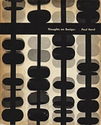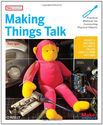-
About
- About Listly
- Community & Support
- Howto
- Chrome Extension
- Bookmarklet
- WordPress Plugin
- Listly Premium
- Privacy
- Terms
- DMCA Copyright
- © 2010-2025 Boomy Labs

 Designers Books
Designers Books
Listly by Designers Books
From writers to illustrators, programmers to designers, sculptors to architects—the CreativeMornings community is made up of a myriad of creative types making interesting things every day. From Atlanta to Bangalore, this month promises to highlight those who make and why they do it.
Please add your favorite books on Making.
Source: http://www.designersandbooks.com

Because you can make something, should you? Mary Shelley's Frankenstein was certainly ahead of it's time

From the Publisher. Even the smartest among us can feel inept as we fail to figure out which light switch or oven burner to turn on, or whether to push, pull, or slide a door. The fault, argues this ingenious-even liberating-book, lies not in ourselves, but in product design that ignores the needs of users and the principles of cognitive psychology.

Laszlo Moholy-Nagy, a pioneer typographer, photographer, and designer of the modern movement and a master at the Bauhaus in Weimar, may have come closest to defining the Rand style when he said Paul Rand was "an idealist and a realist using the language of the poet and the businessman.

This first history of American products and the philosophy behind their design, use, and manufacture points to the process - the interaction between industrial technology and culture-that gave form to an American "ethic" in material products and helped shape the life style of its citizens.

Like Roland Barthes, Richard Sennett approaches the making of objects from a very different field, in his case as an academic, social scientist and the founding director of the New York Institute for the Humanities, who is best known for his work on the sociology of cities.

Victor Papanek didn't think much of designers-industrial designers especially. "There are professions more harmful than industrial design, but only a few of them," he wrote in the opening line of Design for the Real World. "And possibly only one profession is phonier.

Jonathan Chapman makes an articulate case for the need for objects and buildings with strong narratives that can help forge bonds with users through their inherent storytelling qualities.

If a country wants to remain economically vibrant, it needs to manufacture things. In recent years, however, many nations have become obsessed with making money out of selling services, leaving the real business of manufacturing to others. Makers is about how all that is being reversed.

There was a time, as recently as the 1980s, when storefronts, murals, banners, barn signs, billboards, and even street signs were all hand-lettered with brush and paint. But, like many skilled trades, the sign industry has been overrun by the techno-fueled promise of quicker and cheaper.

Debbie Millman's illustrated essays and visual poems are part philosophy, part art, part deeply personal memoir exposing the universal triumphs and tribulations of being human. Her hand-lettered typography-sometimes tender, sometimes gritty, always breathtaking in its visceral candor-makes Self-Portrait as Your Traitor a moving masterpiece of a singular art form that speaks to our deepest longings for beauty, honesty, and the ineffable magic of what it means to live.

While a graduate student at the Royal College of Art, Thwaites undertook to build an electric toaster from raw materials. His account of extracting iron from rock, hand-carving a wooden mold for forming molten plastic, precipitating copper out of pools of acidic mine waste, and melting Canadian coins for their nickel manages to be both hilarious and sober.

A book that mixes practical how-tos with inspiration on what's possible when we add communication and digital smarts to physical objects.

When this book first appeared in 1972, it was part of the spirit that would define a new architecture and design era-a new way of thinking ready to move beyond the purist doctrines and formal models of modernism. Charles Jencks and Nathan Silver's book was a manifesto for a generation that took pleasure in doing ...

From the Publisher. A manifesto for a radically different philosophy and practice of manufacture and environmentalism. "Reduce, reuse, recycle," urge environmentalists-in other words, do more with less in order to minimize damage.

From the Publisher. Acquired of the Angels documents the two most prominent luthiers (guitar makers) of the 20th century. John D'Angelico and James L. D'Aquisto created beautiful, functional works of art from the 1920s until 1995. Their instruments have always been highly respected by players, and in the last decades of the 20th century their appeal has spread to musical instrument collectors.

Sudjic charts our relationship--both innocent and knowing--with all things designed. From the opulent excesses of the catwalk to the playfulness of an Alessi jam jar, he shows how we can be manipulated and seduced by our possessions.
